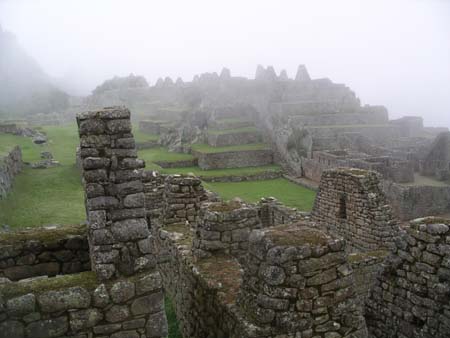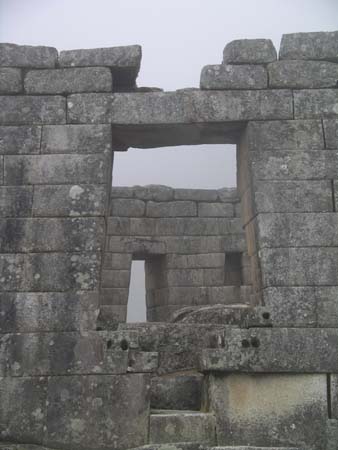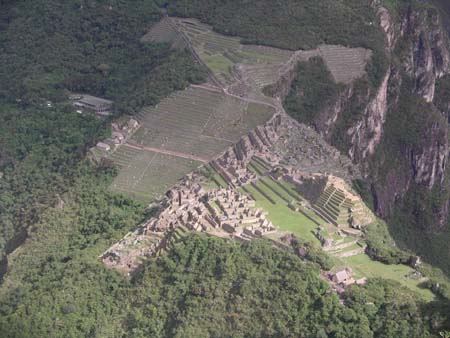Saturday, May 8
Steve: We awoke early today to see Machu Picchu at sunrise.
Although we could see fog and mist outside our window, this did not deter
us from getting up and walking through the entrance gate right at its 6:00AM
opening time. Since at this altitude we are basically in the clouds (Machu
Picchu does indeed sit in a cloud forest), the fog and clouds often move rapidly,
creating very mysterious and often beautiful effects. We wanted to see the
ruins in the early morning before anyone else arrived, even in fogg y
conditions.
y
conditions.
We started by walking up to the guard house to see the view from above. When
we started the 10-minute climb, we could see that the ruins were shrouded
in clouds but still visible. However, by the time we had made our way up the
rocky steps, the fog was so thick that we couldn't see anything at all. After
a few minutes with no change in conditions, we headed back down to the actual
ruins. Although we had no idea of what we were seeing, we loved walking through
Machu Picchu all alone in a very heavy mist. We could just barely discern the outlines of structures
above and all around us, but could not see any of the mountains that we knew
were surrounding us. We wandered for as long as we could, returning to the
lodge for breakfast in time to meet Hilda who was arriving from Aguas Calientes
at 8:00AM to help us begin our exploration of Machu Picchu.
in a very heavy mist. We could just barely discern the outlines of structures
above and all around us, but could not see any of the mountains that we knew
were surrounding us. We wandered for as long as we could, returning to the
lodge for breakfast in time to meet Hilda who was arriving from Aguas Calientes
at 8:00AM to help us begin our exploration of Machu Picchu.
 Machu
Picchu was accidentally discovered by an American archaeologist named Hiram
Bingham in 1911. Bingham was in Peru to search for the fabled last city of
the Incas, the place now called Vilcabamba where the last Inca king, Manco
Inca, had fled after being defeated by the Spanish. After discovering Machu
Picchu, Bingham spent years clearing, excavating and studying the site, and
wrote a book entitled
Machu
Picchu was accidentally discovered by an American archaeologist named Hiram
Bingham in 1911. Bingham was in Peru to search for the fabled last city of
the Incas, the place now called Vilcabamba where the last Inca king, Manco
Inca, had fled after being defeated by the Spanish. After discovering Machu
Picchu, Bingham spent years clearing, excavating and studying the site, and
wrote a book entitled  Lost
City of the Incas that describes his adventures and findings (we have all
been reading this book during our stay here). Machu Picchu is considered one
of the most important (and probably the most spectacular) archaeological findings
in the Americas, and there is a great deal of mystery that still
Lost
City of the Incas that describes his adventures and findings (we have all
been reading this book during our stay here). Machu Picchu is considered one
of the most important (and probably the most spectacular) archaeological findings
in the Americas, and there is a great deal of mystery that still  surrounds
this magnificent lost city. This is one of the few sites that was never discovered
by the Spanish, and thus did not suffer the same destruction that befell most
other Inca structures.
surrounds
this magnificent lost city. This is one of the few sites that was never discovered
by the Spanish, and thus did not suffer the same destruction that befell most
other Inca structures.
Machu Picchu translates to "Old Mountain", and was named by two
families  who
were living here before Bingham arrived. The name "Machu Picchu"
actually refers to the mountain whose peak is visible high up to the south
of the ruins, and the ruins themselves have taken on the same name as this
mountain.
who
were living here before Bingham arrived. The name "Machu Picchu"
actually refers to the mountain whose peak is visible high up to the south
of the ruins, and the ruins themselves have taken on the same name as this
mountain.
As we began our exploration this morning with Hilda, we learned that although
many theories exist, Machu Picchu is considered by most to have been an important
Inca sanctuary, home to over 500 people. It consists of several temples, astronomical
structures, tombs and a large area that was used for housing. There is a central
area now called the "Sacred Plaza" that houses the two main temples
of  Macchu
Picchu. From here a large staircase leads up to a giant sun dial whose shadows
precisely identify the timing for the winter and summer solstices. The only
circular building in Machu Picchu is called "The Sun Temple" and
appears to have had astronomical purposes.
Macchu
Picchu. From here a large staircase leads up to a giant sun dial whose shadows
precisely identify the timing for the winter and summer solstices. The only
circular building in Machu Picchu is called "The Sun Temple" and
appears to have had astronomical purposes.
Because there are no written records from Machu Picchu (the Incas had no written language), there are many mysteries about what we see here today. In each building or room that we explored, it was fascinating to hear alternative explanations for what we were seeing. Archaeologists have done their best to interpret the function and meaning of many puzzling elements of Machu Picchu (unusual carvings, odd windows, etc.), but many secrets still remain. New theories are being developed all the time.
 Machu
Picchu is well-known for its impressive stonework, employing the same combination
of designs that we have seen at Pisac and Ollantaytambo. What is considered
amazing is what the Incas accomplished with only the most basic of tools.
Several years ago,
Machu
Picchu is well-known for its impressive stonework, employing the same combination
of designs that we have seen at Pisac and Ollantaytambo. What is considered
amazing is what the Incas accomplished with only the most basic of tools.
Several years ago,  researchers
demonstrated one technique that the Incas may have used to cut the huge blocks
of white granite that were used here. Blocks of wood were inserted into small
holes were made along the fissures of the rocks. Through repeated cycles where
water was poured onto the wood and allowed to freeze, the granite eventually
broke apart, often making clean breaks. We obse
researchers
demonstrated one technique that the Incas may have used to cut the huge blocks
of white granite that were used here. Blocks of wood were inserted into small
holes were made along the fissures of the rocks. Through repeated cycles where
water was poured onto the wood and allowed to freeze, the granite eventually
broke apart, often making clean breaks. We obse rved
a large rock that the researchers had used to actually demonstrate this technique.
rved
a large rock that the researchers had used to actually demonstrate this technique.
David and Katie particularly enjoyed considering various ideas for how the
Incas did their building, and in particular trying to develop answers for
some questions that still remain regarding the construction techniques that
were used. For example, for no apparent reason, the Incas sometimes broke
their pattern of using closely-fitted large rocks, instead inserting much
smaller stones to fill in the gaps. 
One thing we learned is that although Bingham is highly regarded for having discovered Machu Picchu, much of the work he did has greatly hindered ongoing research about the ruins. Upon its discovery, the entire site was burned and cleared, and major excavations were done. Several of these diggings required walls to be taken down - these were subsequently rebuilt, but it's not clear how accurately this work was done. Bingham took liberties in doing reconstruction of certain elements at Machu Picchu, and it was interesting to see pictures of specific structures (such as the "serpent window" in the Temple of the Sun) which now look different from when they were first discovered.
 As
we continued our fascinating walk through the ruins at a deliberately slow
pace, the weather suddenly started to clear. Almost immediately, the fog had
lifted and we could see not only the scale of the structures that surrounded
us,
As
we continued our fascinating walk through the ruins at a deliberately slow
pace, the weather suddenly started to clear. Almost immediately, the fog had
lifted and we could see not only the scale of the structures that surrounded
us, but also the spectacular scenery all around. A major part of Machu Picchu's
grandeur is its stunning setting high in this cloud forest nestled on a slope
that extends off the bottom of a peak called Huayna Picchu (translates to
"young mountain") among dramatic mountains and cliffs. With the
clearing
but also the spectacular scenery all around. A major part of Machu Picchu's
grandeur is its stunning setting high in this cloud forest nestled on a slope
that extends off the bottom of a peak called Huayna Picchu (translates to
"young mountain") among dramatic mountains and cliffs. With the
clearing  skies,
we decided to make our way back up to the guard house to take in the view
(and take more pictures, of course), saving the rest of our tour for later
this afternoon.
skies,
we decided to make our way back up to the guard house to take in the view
(and take more pictures, of course), saving the rest of our tour for later
this afternoon.
The guard house provides a wonderful perspective from which to view the entire setting for Machu Picchu. It is set among many Inca terraces, and it's possible to walk along these grassy areas and see the ruins from a variety of angles. It is also wonderful to sit and relax on the terraces, simply admiring the fantastic views, and we spent the rest of the morning doing just that.



After lunch, we decided to make the climb up Huayna Picchu, which is the impressive mountain that shoots up directly behind Machu Picchu and appears in all of the classic photographs of the ruins (it's the large mountain in the two pictures above). Huayna Picchu appears very intimidating (at least for recreational hikers like ourselves), since it's basically a straight and very steep shot up. In fact, it was amazing to us that there's even a way to get up at all, but apparently the Incas built a trail because they conducted some sort of ceremonies at the summit.
 All
hikers must register at the start of the trail, and be back down by 4:00PM
(to avoid having rescue teams dispatched!). After a brief initial descent
(never a good thing when you know how high you must climb…), we quickly
found ourselves puffing away on a very steep set of rocky steps. The trail
is very exposed, and we were happy to find and use the ropes and wire cables
that have been installed in some of the trickier spots. While we took several
rest stops along the way, we clearly have all begun adjusting to the higher
altitudes and found that we were no longer getting winded so quickly.
All
hikers must register at the start of the trail, and be back down by 4:00PM
(to avoid having rescue teams dispatched!). After a brief initial descent
(never a good thing when you know how high you must climb…), we quickly
found ourselves puffing away on a very steep set of rocky steps. The trail
is very exposed, and we were happy to find and use the ropes and wire cables
that have been installed in some of the trickier spots. While we took several
rest stops along the way, we clearly have all begun adjusting to the higher
altitudes and found that we were no longer getting winded so quickly. 
Near the top of the trail, we reached a set of very narrow steps that were the steepest we had seen yet. As we climbed carefully, often needing to use both hands above us, Hilda told us that these were very similar to the steps on the Inca Trail that Bingham used when he discovered Machu Picchu.
We reached the summit in exactly 38 minutes (David was proudly up in 32 minutes!),
and took some pride in achieving this feat in less than the 45 minutes that
the signs said would be required. Our reward made the climb well-worthwhile.
Standing on the rocks at the top, we had a spectacular 360-degree view including a
fantastic perspective looking down on Machu Picchu and its terraces (pictured
on the right). From here we were looking at Machu Picchu from a totally new
direction, and Hilda pointed out how the ruins and terraces roughly form the
shape of a condor. M
on the rocks at the top, we had a spectacular 360-degree view including a
fantastic perspective looking down on Machu Picchu and its terraces (pictured
on the right). From here we were looking at Machu Picchu from a totally new
direction, and Hilda pointed out how the ruins and terraces roughly form the
shape of a condor. M ost
Inca cities were designed in the shape of animals, and many believe that Machu
Picchu was indeed constructed to resemble this large Andean bird.
ost
Inca cities were designed in the shape of animals, and many believe that Machu
Picchu was indeed constructed to resemble this large Andean bird.
 We
were the last hikers up Huayna Picchu today, and it was great to enjoy the
views in solitude. However it was getting late and we of course needed to
be down by 4:00PM, so we reluctantly began to climb back down. Walking downhill
on such a steep trail is in some ways harder than going up, so we made sure
to take our time to avoid any mishaps and arrived safely at
We
were the last hikers up Huayna Picchu today, and it was great to enjoy the
views in solitude. However it was getting late and we of course needed to
be down by 4:00PM, so we reluctantly began to climb back down. Walking downhill
on such a steep trail is in some ways harder than going up, so we made sure
to take our time to avoid any mishaps and arrived safely at  3:50PM.
3:50PM.
With Machu Picchu now almost entirely empty of tourists, it was great to
complete our tour in the late afternoon sun. We walked through some of the
residential areas, containing some additional tombs and places where it is
believed that the dead were mummified. There are additional unsolved  mysteries
in this area of Machu Picchu, including two circles carved into rocks in the
floor of a room. These were originally thought by Bingham to be used for grinding
corn, but now researchers don't believe that this is the case and many theories
exist. This is just one example of many of Machu Picchu's puzzles.
mysteries
in this area of Machu Picchu, including two circles carved into rocks in the
floor of a room. These were originally thought by Bingham to be used for grinding
corn, but now researchers don't believe that this is the case and many theories
exist. This is just one example of many of Machu Picchu's puzzles.
After a long and wonderful day, we retreated to the comfort of the Sanctuary Lodge, enjoyed a great dinner and rested our tired bodies. Tomorrow we plan to see another sunrise here (this time hopefully without fog) and to take a hike to a nearby Inca bridge. We'll also probably spend more time walking in the ruins before we leave on our mid-afternoon train back to Ollantaytambo.
.jpg)
